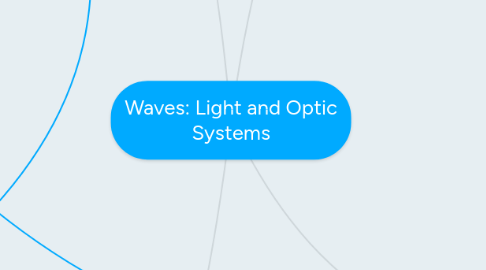
1. Light Waves
1.1. Visible Light Spectrum- Colours formed when white light refracts
1.1.1. Every colour refracts at a slightly different angle
1.1.1.1. Colours Wavelength.
1.1.1.1.1. Red
1.1.1.1.2. Orange
1.1.1.1.3. Yellow
1.1.1.1.4. Green
1.1.1.1.5. Cyan
1.1.1.1.6. Blue
1.1.1.1.7. Violet
1.2. Theory of Colour addition- mixing of three or more colours of light to produce many different colours
1.2.1. Television uses green, blue and red to make images. By changing the brightness of the dots, different colours can be produced
2. Electromagnetic Spectrum
2.1. Energy we can not see but can use (The Invisible Spectrum)
2.2. Application
2.2.1. Radio Waves
2.2.1.1. Can be used in medicine to produce images of tissue deep inside the body.
2.2.2. Mircowaves
2.2.2.1. RADAR= RAdio Detection And Ranging. Send out short bursts to detect objects.
2.2.3. Visible Light
2.2.4. Ultraviolet UV
2.2.4.1. Higher frequency than visible light.
2.2.4.2. Energy is enough to kill living cells - can lead to cancer.
2.2.4.3. Can be good as it has vitamin D which keeps bones healthy.
2.2.4.4. Can treat jaundice in babies.
2.2.4.5. Sun Rays- can be blocked by sunscreen as it is an opaque layer that prevents the rays from passing
2.2.5. X-Rays
2.2.5.1. Have trouble going through the bone so are useful in medical imaging
2.2.6. Gamma Rays-
2.2.6.1. Shortest wavelength and highest frequency.
2.2.6.2. Too much can cause harsh diseases.
2.2.6.3. Can kill off cancer cells.
3. Lowest Frequency
4. Highest Frequency
5. Primary Colours of the Visible Light Spectrum are Red, Blue, and Green. Secondary Colours are Cyan, Magenta and Yellow
6. Primary Colours of the Regular Art Spectrum is Red, Blue, and Yellow. Secondary Colours are Violet, Orange, and Green
7. Properties
7.1. Amplitude- the height of a wave from the rest position to the crest (highest point)
7.2. Wavelength- the distance from the crest of one wave to the crest of another
7.3. Frequency- the number of times the medium vibrates in a given unit of time
8. Producing Visible Light
8.1. Artificial= Man Made
8.1.1. Incandescent
8.1.1.1. Energy runs through the filament and produces light
8.1.1.2. 95% heat 5% light
8.1.2. Fluorescent
8.1.2.1. Has mercury vapour and inside of bulb is coated in a white powder called phosphor.
8.1.2.2. Makes UV Radiation and when it hits the phosphor, visible white light emits.
8.1.2.3. 80% heat 20% light
8.2. Phosphorescent- Can store and emit light
8.3. Natural Sources of Light
8.3.1. Bioluminescence
8.3.1.1. Living organisms that can produce their own light
8.3.1.1.1. Photophore- Light producing organ. Is cause by a chemical reaction
8.3.1.2. This time of light gives off no waste heat, so is called cool light
8.3.2. Most important source of light is the Sun

